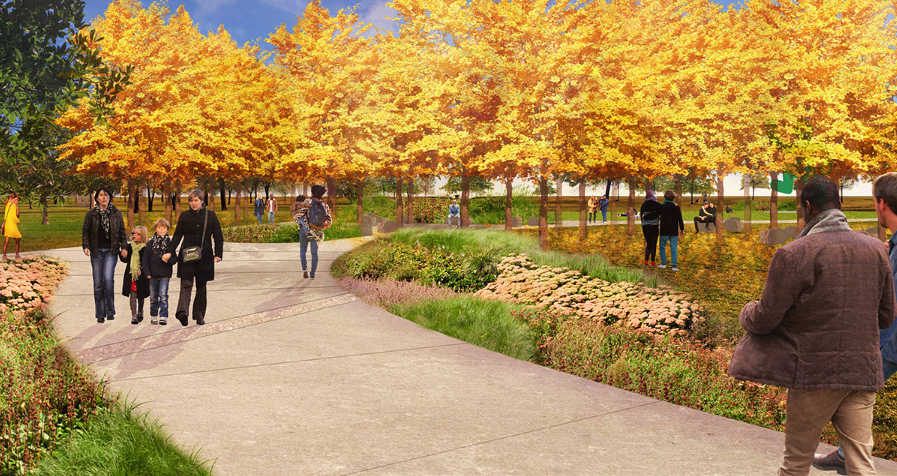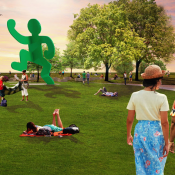Author: Manisha Kaul
AIDS Garden Chicago: A Garden Design That Will Heal and Inspire the Chicago Community
AIDS Garden Chicago, designed by Design Workshop, is a realization of a design idea, close to Alderman Tom Tunny’s heart, for a garden championed by him and a number of community organizations. The garden surrounds a 30-foot-tall sculpture designed by the late artist and activist, Keith Haring and donated to the Chicago Park District through the efforts of Ald. Tunny and support from the Chicago Parks Foundation. The sculpture, a self-portrait of Keith, was installed in November 2019. The AIDS Garden Chicago will be Chicago’s first public space to memorialize the early days of Chicago’s HIV epidemic, and to honor those who continue to fight against the disease today.
Anticipated to be completed in 2020, the 2.5-acre garden is located along the magnificent shoreline of Lake Michigan just south of Belmont Harbor at the original location of the Belmont Rocks – a space where the local LGBTQ community gathered between the 1960s and 1990s. Surrounding the sculpture are unique garden areas designed for reflection, hope, education, healing and celebration. Visitors are guided along a serpentine path that weaves through a variety of sensory and intimate garden experiences, the most notable being a memorable grove of Gingko trees.
Main Garden Entrance
The main entrance to AIDS Garden Chicago, off the Lakefront Trail, presents a perennial garden of native plants alongside a cluster of Gingko trees (Ginkgo biloba), a combination entry sign and donation wall, a dedication bench, bicycle racks, with the gracious Serpentine Pathway leading the visitor to the Celebration Lawn. A custom-design limestone ledge is integrated into the seating area as a reminiscent of the original Belmont Rocks. Ginkgo trees that are integral to the design concept stand stoically adjacent to the entry sign wall with gracefully cascading hand-cast bronze donor plaques as fan-shaped Ginkgo leaves act as an extension of the tree’s broadly spreading canopy. As visitors’ approach, planted berms of magnificent bunchgrass enclose the main entryway, framing a view to the focal point of the garden: the 30-foot-tall “Self-Portrait” sculpture.
Serpentine Pathway and Education Walk
The curvy pathway emanating from an oval composition around the sculpture, defines the primary circulation route that unifies the diverse spaces of the garden. A row of Freeman Maples (Acer x freemanii, ‘Autumn Blaze’) and colored concrete bands in a recognizable rhythm leads views to temporary art exhibit locations, future home to art installations by community members. These exhibits are intended to fulfill the education mission of the garden. The distinct paving pattern extends to other garden areas to engage and guide the visitors.

Image: Design Workshop
Unity Garden
Adding color and movement throughout the seasons, the planting design of the Unity Garden draws from native deciduous and evergreen shrubs, ornamental prairie grass brough to life with colorful perennials. Mature, existing trees form the overstory, while flowering Witch-Hazel (Hamamelis virginiana) fill the understory. The rich plant palette is designed to attract birds and pollinators while responding to the specific climate conditions of the proximal Lake Michigan–flat, cool, and windy. These gardens will be planted to and maintained under the direction of volunteer gardeners from across the city and will imbue a feeling of healing through unity.
Reflection Grove
A graceful grove of Gingko trees defines an area of the garden well suited for quiet reflection. Transforming the existing lawn area to an intimate grove of Ginkgo trees, planted twenty feet on-center–acting as a canopy of lush foliage, the Ginkgo trees were thoughtfully selected for their resilience, aesthetic benefit and cultural anecdotes. Considering all other species in the Ginkgophyta division are extinct, Ginkgo biloba offers a perfect symbology of recovering from hardship and promotes a cultural narrative of healing. It also offers a strong visual interest with its simple, deep green fan like form in the spring and summer; and a magical gold blanket of leaves that drop in a single day in the fall. Visitors of all abilities can enjoy the shade offered by the tree canopy with wheelchair accessible areas interspersed with more naturalistic boulder seating.
Celebration Lawn
Emerging from the heavily shaded Reflection Court is a large, oval lawn that provides a backdrop to the 30-foot tall “Self-Portrait” sculpture by artist Keith Haring. This landscape section is deliberately left un-programmed, so that the visitor has freedom and flexibility to experience the space in a passive or active manner. Historically, the Belmont Rocks was not only an area to sunbathe for LGBTQ+ people, but was a liberating environment that allowed stigmatized individuals to liberate themselves in the daylight. To celebrate that proud spirit within the landscape, decorative paving bands symbolizing sun’s rays radiate from the center of the sculpture to the perimeter walk, creating a celebratory environment.
AIDS Garden Chicago is well poised to be a successful public space; one that will bring together a diverse coalition of partnerships in support of a one-of-a-kind Chicago landmark. A garden for all – a place for reflection, celebration, hope, education, community, healing and most of all inclusion.
—
This article was written by:

Manisha Kaul (Design Workshop)

Sophia Essian (Design Workshop)
Lead Image: Design Workshop




